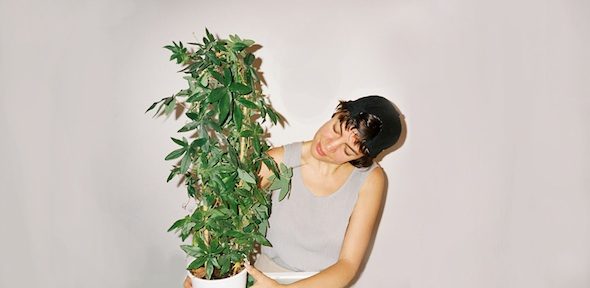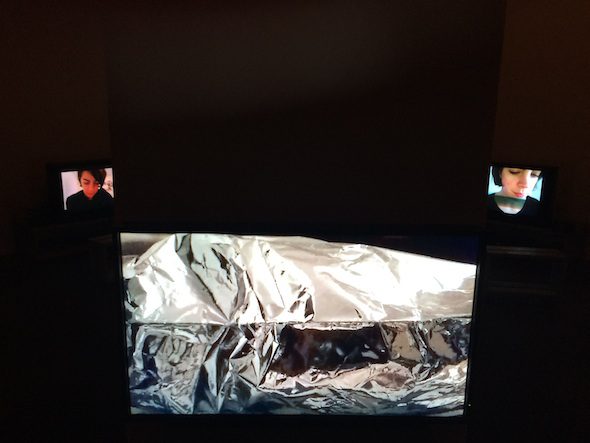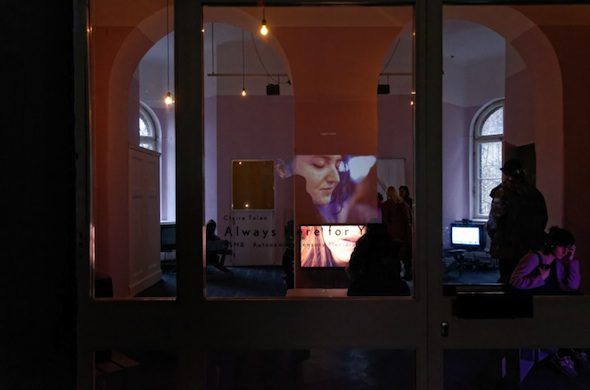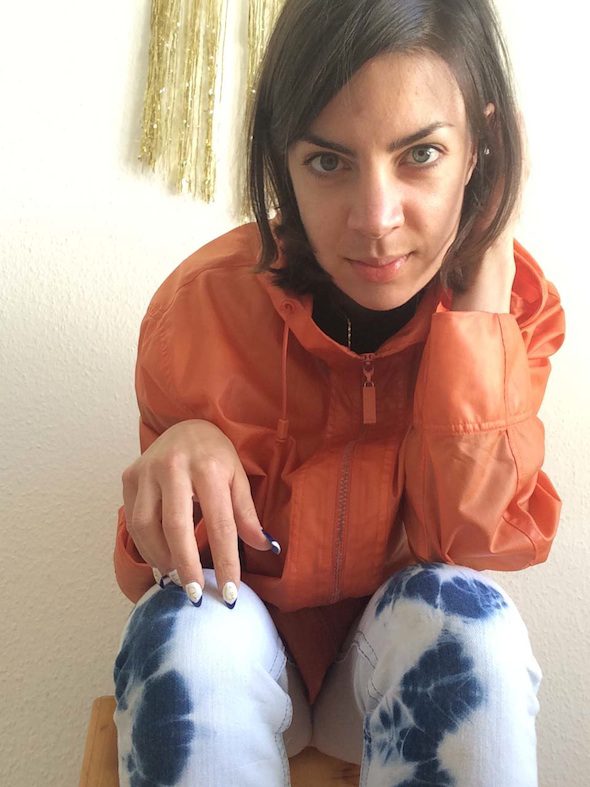Interview by Alison Hugill in Berlin; Tuesday, Jul. 14, 2015
Claire Tolan is off to London for the rest of the summer to do a sound art residency at The White Building, where she plans to build a web platform for ASMR enthusiasts. Auto-Sensory Meridian Response (ASMR) is described as a ‘distinct, pleasurable tingling sensation in the head, scalp, back, or peripheral regions of the body’ as a response to external stimuli. Colloquially known as a ‘braingasm’, the phenomena has swept online communities over the last few years—inaugurating the role of the ASMRtist—and has become a point of fascination in the art world.
 Claire Tolan – Portrait by Anastasia Filipovna, Berlin Community Radio
Claire Tolan – Portrait by Anastasia Filipovna, Berlin Community Radio
Over a year ago, Tolan developed a radio show called ‘You’re Worth It’ for Berlin Community Radio, in which she triggers ASMR through whisper-soft narrative and object-play. Tolan also presented a multi-screen installation at the CTM Festival’s Untune exhibition in Kunstraum Kreuzberg/Bethanien early this year. We caught up with her in a cafe in Neukölln to discuss her interest in ASMR, community building, and public intimacy.
Alison Hugill: What is ASMR to you?
Claire Tolan: The whole reason that ASMR exists as a community is because of the tingling sensation. But for me this is not one of the aspects that I necessarily focus on. It’s a byproduct of my work but it’s not my primary interest. I am primarily interested in two things: one is how the community that formed around this tingling sensation has become a community of care. The videos are used to ease anxiety, cure depression and insomnia. It’s a community of strangers caring for other strangers. Then, I am also interested in how these slow, soft sounds – the dullness of them – are background sounds that exist all the time, in every room and in every landscape. I think a lot about how ASMR can be seen as a perceptual re-training to develop a keen vision for this soft everyday. The idea that the sound of my tapping on a glass could be somehow relaxing is possible if you train yourself to be more aware of your surroundings.
For example, one of my favourite ASMR sounds is the plastic bottle lids. The sound is so nice to me. But it’s only after working with ASMR for so long that I discovered this and now I can’t screw on a bottle lid without thinking about it. In some ways it’s a totally mundane, sublime personal experience but I think about the implications of this as a larger perceptual shift.
AH: Tell us about the kind of sounds you produce on your Berlin Community Radio show ‘You’re Worth It’ and what kind of reactions they elicit.
CT: I started out working primarily with content from YouTube, sampling videos that I thought were interesting. Over the past year and a half that I’ve had the show on BCR I started recording, more and more, my own material: now I’m about a half-and-halfer. On my show, anything goes if it’s in an ASMR register, or somehow working with the culture and the phenomenon in an interesting way.
What I’ve been focussing on recently are accidental ASMR recordings from YouTube and my own experiences. Kind of this background noise I was talking about: like if someone is recording a video, and when they watch it they think it sounds like ASMR. Accidental ASMR. Some of my favourite videos are like that. I have this one video I’ve used in several shows, that’s constantly breaking the same video apart. It’s one of these accidental ASMR videos. I also found a hilarious playlist someone had compiled of every moment of whispering in the show Big Brother, Season 7.
Other than that it’s been a very broad range of ASMR sounds with no specific subject focus. In the installation Always Here For You at CTM Festival there was a series of videos installed and some performances in a glass room. The videos and performances were focussed around ideas of privacy and surveillance, watching and being watched. In the past two years I have been working for different NGOs that are dealing with privacy and anti-surveillance advocacy. So I decided to think about my professional work through the lens of ASMR. Particularly because I am so fascinated by this relationship between the viewer and the ASMRtist. The ASMRtist is directly addressing the viewer as though they were familiar, and the viewer is looking into this very intimate setting. The videos are amateur so they are usually filmed in the house of the ASMRtist but there’s no actual knowledge of the other person. This creates an interesting tension.
 Claire Tolan – “Always Here For You” (2015), CTM Festival; Courtesy of the artist
Claire Tolan – “Always Here For You” (2015), CTM Festival; Courtesy of the artist
 Claire Tolan – “Always Here For You” (2015), CTM Festival; Photo by raumlaborberlin, courtesy of the artist
Claire Tolan – “Always Here For You” (2015), CTM Festival; Photo by raumlaborberlin, courtesy of the artist
AH: You’ve spoken before about this idea of public intimacy. Is that something that you’ve been theorizing?
CT: Yeah. I’ve been walking around that idea. And recently I’ve also been very interested in theories of hospitality, and what it means to welcome and care for strangers. How familiar are you with a stranger and how familiar are you capable of being? What does it mean to be a good host?
Specifically I’ve been doing performances in the past few months, in settings where I welcome people as they enter and then compliment them. It’s a lot of empty platitudes of “Hello” and “You look great!” but then you think about what’s behind the platitudes. I’m from the American Mid-West and we are famous for this.
AH: People really talk to you all the time in America. But that seems to me to be born out of the service industry and the fact that so many people, of all ages, are employed in it.
CT: That’s true to a certain extent but I’m from a small town and it’s more that you’re just familiar with people walking down the street. This is seen as very funny by people who are not from this culture, it’s seen as empty or worthless. But I don’t think it’s empty or worthless. I don’t think everyone who is calling me Baby Doll is close enough to me to be calling me that, but I do think there is some form of care behind these platitudes.
In ASMR you don’t have this physical closeness but you have a vocal closeness that tries to make up for the lack of physical proximity.
AH: Your background is, partly, in the study of human-computer interaction: in your exploration and practice of ASMR, how do you see the potential healing properties of this online phenomena in terms of community building and ‘public intimacy’?
CT: The Human-Computer Interaction (HCI) stuff comes out of my one year of grad school. I was studying digital archives and this opened up into this larger study of information science, which is where I began to learn how to code. HCI in information science land means thinking a lot about the way users use computer systems and how you design them to be friendly.
Since I studied archives and interaction, I’m very interested in how this ASMR community exists on YouTube. It’s only on YouTube, and the YouTube interface is what it is. The role of the ASMRtist and the viewer is defined by the allowances of the YouTube interface. There have been some attempts to create ASMR forums outside of YouTube. These exist but they always kind of fade out; there was one called Soothe Tube that just imported ASMR videos from YouTube and then allowed different kinds of functionality. But now this one is gone.
Outside of this interface dissection, I think it’s really interesting for people who otherwise have nothing in common to have something to talk about: ASMR seems to be something that people love to talk about.
AH: Do you have a vision of another platform for this?
CT: I think so. In basic terms of uploader rights to videos, YouTube can take down anything it thinks is inappropriate. It’s hard to say though, because ASMR has grown inside of YouTube so I think the imagination for it has in some ways been restricted. Now you see people working with Oculus in ASMR, or some 3D video things. It’s starting to happen. During my residency at The White Building in London, I’m going to build a custom ASMR platform, which will host a series of multiple choice quizzes. Each quiz is a collaboration with a different person. Users will go through the quiz and every multiple choice answer will be linked to a very short video clip. When you finish the quiz you will get a compiled video which is your answer. I’m interested in working off of YouTube and to date I have not put any videos on YouTube.
AH: In your radio interview on the BCR show Hystereo, you mentioned that you first came across ASMR in the context of research into fetish videos online. What are the sexual and gendered dimensions of ASMR that you see?
CT: The way I found out about ASMR was because I was fascinated by these videos on YouTube of women, dressed in high heels and stepping on pool toys, or Doritos, or this kind of thing. I was always fascinated by yawning videos, so this was a fascination that could easily lead into ASMR. I quickly found out there were yawning fetish videos and I was like WHAT IS THIS WORLD?
What was interesting to me about fetish videos was the landscape they were occurring in. People have different ideas about what is sexual. They are called fetish videos because they display “abnormal” attention to objects. But they aren’t made to be sexual most of the time, and I don’t think that they are. One of the reasons they are seen this way is because we read closeness from strangers as sexual, because we don’t have any other category of intimacy to shove it into. ASMR is very interesting because it shows there are other ways to have a stranger very close to you and maybe we should think about a classification for this that is not automatically sexual, which seems to flatten the videos in a way that isn’t fair to them.
At the same time, obviously some people are making sexy ASMR. It exists, but it’s a small portion of the ASMR output. In terms of gender roles: the videos are often made by young women, but I see that more and more men are also making the videos. I think we can still read really interesting gendered things into them, since the role of the caregiver is so often a feminine role. One thing that you see in ASMR videos is the over-performance of care, so as to break this expectation of the care. This too-perfect care is not often done but it can be done. Care that is not tethered to any reality.
There’s a really nice queerness to it as well, that I am getting pleasure from objects. It’s bizarre, not necessarily sexual, undefinable pleasure. Objects have this pleasure-inducing power.
AH: Do you think we are seeing a new marketization of care as a ‘product’ that can be packaged and delivered anonymously through the web? Is the so-called care economy being taken to its dystopian logical conclusion, or what effects do you see that having?
CT: I think that what is so great and complicated about ASMR is that you can read it in either direction. I’m inclined to tether myself to the more positive aspects of what can come out of it because the other route feels more closed off to me. If you start reading it negatively then it becomes much less full, I think.
The more famous ASMRtists are now offering different products, so it is becoming packaged to a certain extent: different services or customized videos that allow them to expand beyond YouTube. I think that’s great! Ultimately if someone is watching the video and it makes them feel relaxed then I have no problem with that. In terms of this replacing person-to-person intimacy, that is not because of ASMR. To some extent it already happens all the time.
 Claire Tolan, Portrait; Courtesy of the artist
Claire Tolan, Portrait; Courtesy of the artist
AH: Your work is often received in the art world. How does it relate to art practice and performance?
CT: It’s hard to say for me and I kind of have no idea: I didn’t start out thinking I was an artist. I was a programmer who has this funny interest. Though I have done creative work before and I’ve always been inclined towards that. But now that this practice has grown it is most at home in the art world because, conceptually, it’s dealing with a lot of issues that are also being dealt with by my cohort of artists. It makes more sense in the art world than, for example, in the club. Although I am thinking more and more about what it would be like to make an ASMR record. But mostly I am confused about the boundaries between these genres. I’ve had very little interaction with the ASMR community because I am not posting videos on YouTube, I am kind of coming at it from the outside.
My radio show has a small following but I maybe get between 500 and 1000 listens, which is nowhere near the 100K that someone like Heather Feather is getting [laughs]. Heather Feather is wonderful, and I aspire to having more conversations with ASMRtists. There’s an ASMR Convention in LA this year!
Additional Info
BERLIN COMMUNITY RADIO
Radio Show: You’re Worth It
Bi-Weekly; Next show Tues. Jul. 21, 2015; 7pm
cst.yt
Writer Info
Alison Hugill has a Master’s in Art Theory from Goldsmiths College, University of London (2011). Her research focuses on marxist-feminist politics and aesthetic theories of community, communication and communism. Alison is an editor, writer and curator based in Berlin. alisonhugill.com



















